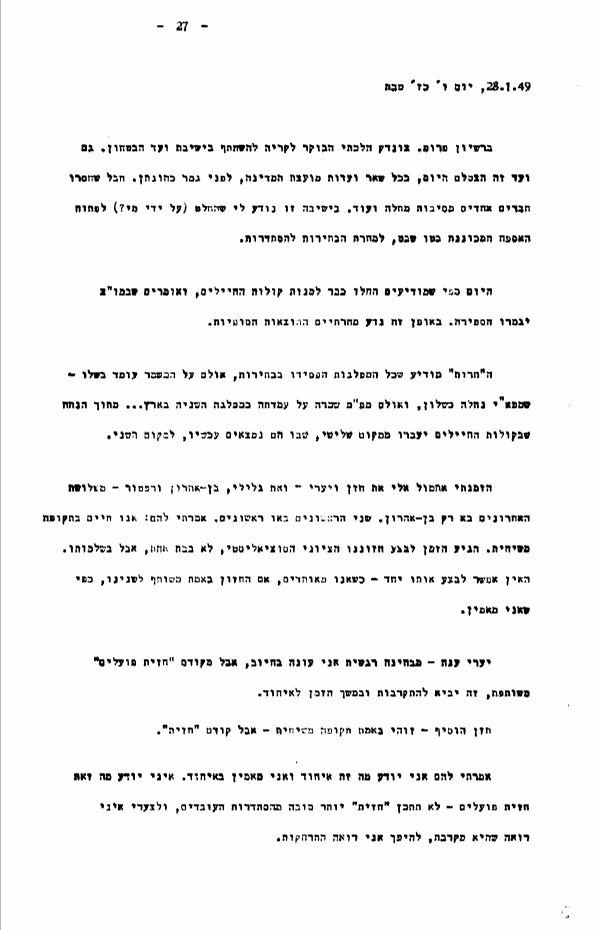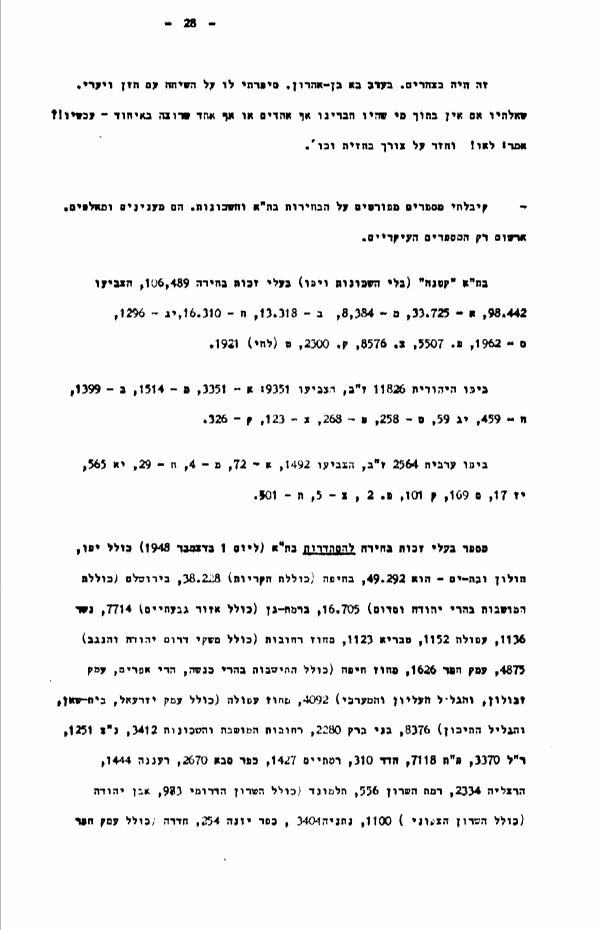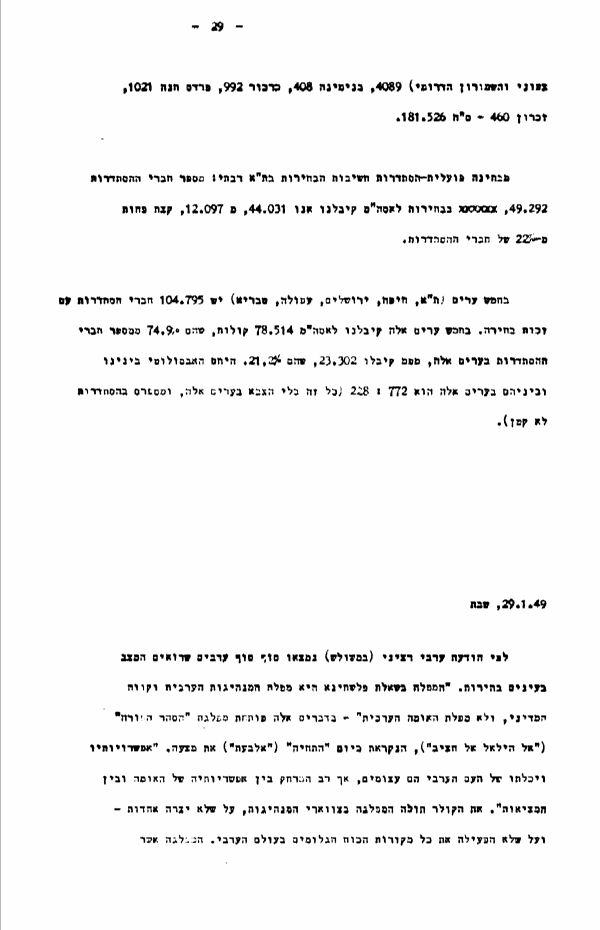1
of
Places:
Even Yehuda
Azor
Nah̠ala
H̠olon
Jaffa
Haifa
Bne Brak
Giv'atayim
Nesher
Afula
Reh̠ovot
Yizre'el
Herzliya
Kfar Sava
Ramatayim
Ra'ananna
Ramat HaSharon
Binyamina – Giv'at Ada
H̠adera
Kfar Yona
Netanya
Karkur
Pardes Hanna
Jerusalem
Jezreel Valley
Bat Yam
Tverya
Sdom
Ramat Gan
Negev
Bet She'an
People:
The use of the photograph is subject to the Copyright Law, 2007
28.01.1949
224852
Friday, January 28, 1949 With Prof. Zondek’s permission, I went to the Kirya [government compound] this morning to participate in the Defense Committee meeting. This committee also had its photograph taken, like all the other State Council committees, before the end of their term. It’s unfortunate that some members were missing because of illness, etc. At this meeting I was informed that it was decided (by whom?) to open the Constituent Assembly on Tu Bishvat [Arbor Day], the day after the Histadrut elections. Today, I’m informed, they’ve already started counting the soldiers’ votes, and they say that they’ll finish the count on Saturday evening. Thus we’ll know the final results in two days. Herut announced that all the parties lost in the elections, but Al HaMishmar stands its ground – that Mapai failed, whereas Mapam maintained its position as the second party in the country … based on the assumption that with the soldiers’ votes they’ll move from third place, where they currently are, to second place. Yesterday I invited [Ya’akov] Hazan and [Me’ir] Ya’ari, and [Yisrael] Galili, [Yitzhak] Ben-Aharon, and [Berl] Raptor. Of the last three only Ben-Aharon came. The first two arrived first. I told them: We live in a messianic era. The time has come to implement our Socialist Zionist vision, not all at once, but in its totality. Can we not implement it together – with us united, if the vision is truly shared by both of us, as I believe. [Me’ir] Ya’ari answered: From an emotional perspective my answer is affirmative, but a joint “labor front” first would bring us closer and in time lead to unity. [Ya’akov] Hazan added – this is truly a messianic era – but first a “front.” I told them that I know what unity is and I believe in unity. I do not know what a labor front is – there can be no better “front” than the workers’ Histadrut, and sadly I do not see it bringing [us] closer, but rather driving [us] apart. That was in the afternoon. In the evening Ben-Aharon came. I told him about the conversation with Hazan and Ya’ari. I asked him whether there aren’t some or even one among those who used to be our associates who want unity – now?! He said: No! And reiterated the need for a front, etc. – I received detailed numbers on the elections in Tel Aviv and the neighborhoods. They’re interesting and instructive. I’ll list only the main numbers. In “lesser” Tel Aviv (without the neighborhoods and Jaffa) there are 106,489 eligible voters; 98,442 voted, A – 33,725, M – 8,384, B – 13,318, H – 16,310, YG – 1,296, S – 1,962, P. 5,507, Tz. 8,576, K. 2,300, T. (LEHI) 1,921. In Jewish Jaffa [of] 11,826 eligible voters, 9,351 voted: A – 3,351, M – 1,514, B – 1,399, H – 459, YG 59, S – 258, P – 268, Tz – 123, K – 326. In Arab Jaffa [of] 2,564 eligible voters, 1,492 voted, A – 72, M – 4, H – 29, YA 565, YZ 17, S 169, K 101, P. 2, Tz – 5, Th – 501. The number of eligible voters for the Histadrut in Tel Aviv (as of December 1, 1948) including Jaffa, Holon, and Bat Yam is 49,292; in Haifa (including the Krayot [a collective term for a groups of towns and neighborhoods in the northern end of the Haifa District]) 38,228; in Jerusalem (including the settlements in the Judean Hills and Sdom) 16,705, in Ramat Gan (including the area of Givatayim) 7,714, Nesher 1,136, ‘Afula 1,152, Tiberias 1,123, Rehovot district (including the southern Judea and Negev settlements) 4,875, Emek Hefer 1,626, Haifa district (including the settlements in the Menashe Hills, Efraim Hills, Emek Zevulon, and the Upper and Western Galilee) 4,092, ‘Afula district (including the Jezreel Valley, Bet She’an, and the Central Galilee) 8,376, Bnei Brak 2,280, Rehovot the settlement and the neighborhoods 3,412, Ness Ziona 1,251, Rishon LeZion 3,370, Petah Tikva 7,118, Hadar 310, Ramatayim 1,427, Kefar Saba 2,670, Ra’anana 1,444, Herzliya 2,334, Ramat HaSharon 556, Telmond (including the southern Sharon[)] 983, Even Yehuda (including the northern Sharon) 1,100, Netanya 3,404, Kefar Yona 254, Hadera (including northern Emek Hefer and southern Samaria) 4,089, Binyamina 408, Karkur 992, Pardes Hannah 1,021, Zichron [Ya’akov] 460 – total 181,526. From a labor-Histadrut perspective, the importance of the elections in greater Tel Aviv: Histadrut members total 49,292; in the elections to the Constituent Assembly we received 44,031, M 12,097, slightly under 22 of the Histadrut members. In five cities (Tel Aviv, Haifa, Jerusalem, ‘Afula, Tiberias) there are 104,795 Histadrut members eligible to vote. In these five cities we received 78,514 votes to the Constituent Assembly, which amounts to 74.9% of the Histadrut members in the cities; Mapam received 23,302, which is 21.2%. The absolute ratio between us and them in these cities is 772: 228 (all this doesn’t include the army in the cities, and their number in the Histadrut is not small).











